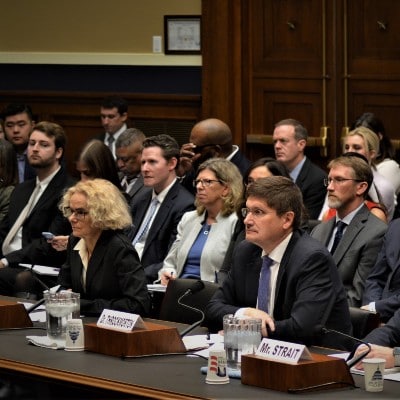 On Jan. 15, the House Energy and Commerce Subcommittee on Health held a hearing on discrepancies between state and federal medical cannabis policy and federal roadblocks to clinical research. Many felt the conversation was long overdue.
On Jan. 15, the House Energy and Commerce Subcommittee on Health held a hearing on discrepancies between state and federal medical cannabis policy and federal roadblocks to clinical research. Many felt the conversation was long overdue.
“I honestly never dreamed I would see, in my lifetime, such progress and discussion on the need for more research on cannabis and CBD at the federal level,” says Ellen Lenox Smith, Co-Director of Medical Cannabis Advocacy for U.S. Pain Foundation. “But to my excitement, it happened, and it was a thorough discussion, lasting three and a half hours.”
An estimated 44 million Americans reported using cannabis last year. Presently, 33 states allow medicinal use and 11 states, plus the District of Columbia, also allow recreational use. However, federal and state policies are miles apart and there are strict federal restrictions on research.
The goal of the hearing was also to explore some of the current bills related to cannabis use and research. Right now, there are six federal bills on the topic:
- H.R. 171, the “Legitimate Use of Medicinal Marijuana Act”
- H.R. 601, the “Medical Cannabis Research Act of 2019”
- H.R. 1151, the “Veterans Medical Marijuana Safe Harbor Act”
- H.R. 2843, the “Marijuana Freedom and Opportunity Act”
- H.R. 3797, the “Medical Marijuana Research Act of 2019”
- H.R. 3884, the “Marijuana Opportunity Reinvestment and Expungement Act of 2019” or the “MORE Act of 2019”
A summary of these bills can be found here, in a memo circulated prior to the hearing.
The hearing brought together representatives from three federal agencies:
- Matthew J. Strait, Senior Policy Advisor, Diversion Control Division Drug Enforcement Administration
- Douglas Throckmorton, MD, Deputy Director for Regulatory Programs, Center for Drug Evaluation and Research Food and Drug Administration
- Nora D. Volkow, MD, Director, National Institute on Drug Abuse National Institutes of Health
The three individuals were questioned by the committee on a number of topics, including medical use of cannabis, current challenges their agencies face in approving research, and so on.
[su_pullquote align=”right”]
Read an op-ed on the hearing by Ellen Lenox Smith in Morning Consult.
[/su_pullquote]
The difficulty with research stems from cannabis being listed as a Schedule I drug, alongside drugs like LSD, heroin, and ecstasy. This category is for substances that have no medical value and are considered to have a high potential for abuse. Putting cannabis into this highly controlled category has meant that it takes approval by the National Institutes for Health (NIH), Food & Drug Administration (FDA), and Drug Enforcement Agency (DEA) for the right to research it. In addition, only cannabis from the University of Mississippi is allowed to be used. Along with being in limited supply, this source has proven to lack commercial quality and correct potency to keep up with the sources in various states.
“We are stuck in a catch-22,” says Lenox Smith. “We need to show support for medical use to educate the public, but we aren’t able to conduct the proper research. Thus, we are left with unanswered questions about both cannabis and CBD.”
CBD is uniquely problematic. In December 2018, the Farm Bill removed hemp from Schedule I, but no regulations were established about its safety. So the public now has access to CBD, but there is no standardization or evidence about quality, dosage, possible interactions, and safety. It is in creams, pills, shampoo, food, drinks, and much more.
“People are paying a high price for CBD items and are not always getting what is being sold on the product packaging,” says Lenox Smith. “This needs to be corrected.”
There was a positive agreement when it comes to understanding the use of cannabis for medical use. The three agency representatives and the majority of the legislators present agreed it shows potential for help with pain, neurological disorders like seizures, and nausea, to name a few. In fact, a drug called Epidolix was approved by the FDA in 2018, for those that are two and older with seizures. However, there are also many issues that are not clear and need to be researched further.
[su_spoiler title=”View a list of topics mentioned that need to be further reviewed and clarified.” open=”no”]
- Use nearly doubled by pregnant mothers from 2009-2016. There is a need for research into effects on maternal and fetal health.
- Concerns about use of teens. Possibility of lower academic function, the risk of addiction, psychosis if high THC.
- THC potency varies widely and may be inconsistent.
- FDA says it could take 3-5 years to study and create standards on CBD.
- Lack of research on the risks and benefits for both medical and recreational use. Treatment decision needs to be driven by data. There is little to no data from states with programs – lack data so arbitrary products on the market.
- Hard to identify effects on driving – need to better understand.
- Inconsistencies in punishment for cannabis use.
[/su_spoiler]
Given the many unresolved questions, a second hearing was suggested on several occasions.
“As we move forward, we hope that patients will be included in the next hearing, whose date and time have not been announced yet,” says Lenox Smith. “This hearing brought up concerns that have been on many minds for years now. We need to be sure patients and their doctors are educated with correct, evidence-based information so they can make a safe, intelligent decision about using cannabis and/or CBD.”
U.S. Pain Foundation is running an action campaign to encourage a second hearing, but this time, we ask that the hearing include patients and provider voices. Taking part requires just a few minutes of your time.
